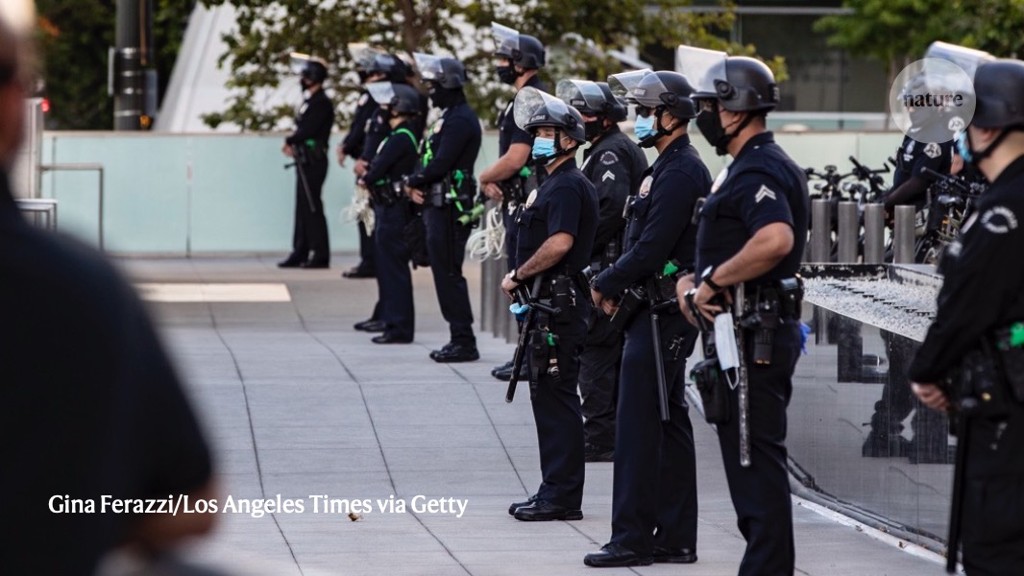Mathematicians urge colleagues to boycott police work in wake of killings
A group of mathematicians in the United States has written a letter calling for their colleagues to stop collaborating with police because of the widely documented disparities in how US law-enforcement agencies treat people of different races and ethnicities. They concentrate their criticism on predictive policing, a maths-based technique aimed at stopping crime before it occurs.
The letter, dated 15 June, is addressed to Notices of the American Mathematical Society (AMS), and comes in the wake of protests in the United States and globally, sparked by the killing of George Floyd by a police officer in Minneapolis, Minnesota, in May. More than 1,400 researchers have signed it (see go.nature.com/3fkwxmb).
In recent years, mathematicians, statisticians and computer scientists have been developing algorithms that crunch data and claim to help police reduce crime — for instance, by suggesting where crime is most likely to occur and focusing more resources in those areas. Software based on such algorithms is used by police departments across the United States, but many contest its effectiveness.
“Given the structural racism and brutality in US policing, we do not believe that mathematicians should be collaborating with police departments in this manner,” the mathematicians write. “It is simply too easy to create a ‘scientific’ veneer for racism.”
“The activity of collaborating with the police is not something we feel a mathematician should be doing,” says co-author Jayadev Athreya, a mathematician at the University of Washington in Seattle. (He and the other writers emphasize that the letter represents their own views and not those of their employers.)
The AMS says that it “has no official position on mathematicians’ involvement in providing expertise to law-enforcement agencies, or to companies that do business with such agencies”.
CERN pushes to build €21-billion supercollider
CERN — Europe’s pre-eminent particle-physics organization — has taken a big step towards building a 100-kilometre circular supercollider to push the frontier of high-energy physics. The decision to pursue the machine was unanimously endorsed by the CERN Council, the organization’s governing body, on 19 June, following the plan’s approval by an independent panel in March.
The accelerator is expected to cost at least €21 billion (US$24 billion) and would be a follow-up to the Large Hadron Collider. It would be built in an underground tunnel near CERN’s location outside Geneva, Switzerland, and smash together electrons and their antimatter partners, positrons, by the middle of the century. The design will enable physicists to study the properties of the Higgs boson and, later, to host an even more-powerful machine that will collide protons in the second half of the century.
The decision is not yet a final go-ahead, and CERN will need global help to fund the project. But the organization can now focus on designing the collider and researching its feasibility. “I think it’s a historic day for CERN and particle physics, in Europe and beyond,” said CERN director-general Fabiola Gianotti.
‘Lava lamp’ effect could make drugs more powerful
Researchers have used a phenomenon called phase separation to concentrate cancer-drug compounds into precise spots within cells — a discovery that could boost drug-development efforts.
Like blobs in a lava lamp or oil shaken in water, cell components such as proteins and RNA can self-organize into liquid-like droplets known as condensates. Research by a team at the Whitehead Institute in Cambridge, Massachusetts, reveals that synthetic compounds can be sequestered in droplets in a similar way. The effect could be exploited to make certain drugs hit their targets more effectively, while limiting harmful side effects.
The researchers tracked the dynamics of five cancer drugs in test-tube experiments and in human cancer cells in culture (I. A. Klein et al. Science http://doi.org/dz3g; 2020). The group found that when mixed with proteins known to form condensates, drugs such as cisplatin cluster into highly concentrated droplets.
The work could also help efforts to find drugs to fight COVID-19. In unpublished work, the same team has found that proteins from the coronavirus clump together in condensates that can absorb and concentrate drug compounds.




